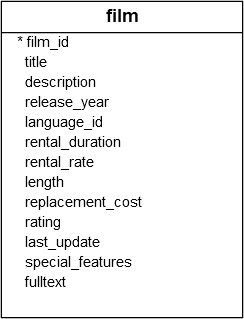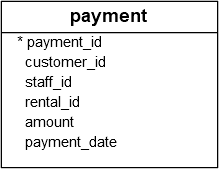Summary: in this tutorial, you will learn how to use the PostgreSQL IN operator to check if a value matches any value in a list.
Introduction to PostgreSQL IN operator
The IN operator allows you to check whether a value matches any value in a list of values.
Here’s the basic syntax of the IN operator:
value IN (value1,value2,...)The IN operator returns true if the value is equal to any value in the list such as value1 and value2.
The list of values can be a list of literal values including numbers and strings.
In addition to literal values, the IN operator also accepts a list of values returned from a query. You’ll learn more about how to use the IN operator with a query in the subquery tutorial.
Functionally, the IN operator is equivalent to combining multiple boolean expressions with the OR operators:
value = value1 OR value = value2 OR ...PostgreSQL IN operator examples
We’ll use the film table from the sample database:

1) Using the PostgreSQL IN operator with a list of numbers
The following example uses the IN operator to retrieve information about the film with id 1, 2, and 3:
SELECT
film_id,
title
FROM
film
WHERE
film_id in (1, 2, 3);Output:
film_id | title
---------+------------------
1 | Academy Dinosaur
2 | Ace Goldfinger
3 | Adaptation Holes
(3 rows)The following statement uses the equal (=) and OR operators instead of the IN operator, which is equivalent to the query above:
SELECT
film_id,
title
FROM
film
WHERE
film_id = 1
OR film_id = 2
OR film_id = 3;The query that uses the IN operator is shorter and more readable than the query that uses equal (=) and OR operators.
Additionally, PostgreSQL executes the query with the IN operator much faster than the same query that uses a list of OR operators.
2) Using the PostgreSQL IN operator with a list of strings
We’ll use the actor table from the sample database:
 The following example uses the
The following example uses the IN operator to find the actors who have the last name in the list 'Allen', 'Chase', and 'Davis':
SELECT
first_name,
last_name
FROM
actor
WHERE
last_name IN ('Allen', 'Chase', 'Davis')
ORDER BY
last_name;Output:
first_name | last_name
------------+-----------
Meryl | Allen
Cuba | Allen
Kim | Allen
Jon | Chase
Ed | Chase
Susan | Davis
Jennifer | Davis
Susan | Davis
(8 rows)3) Using the PostgreSQL IN operator with a list of dates
We’ll use the payment table from the sample database:

The following statement uses the IN operator to find payments whose payment dates are in a list of dates: 2007-02-15 and 2007-02-16:
SELECT
payment_id,
amount,
payment_date
FROM
payment
WHERE
payment_date::date IN ('2007-02-15', '2007-02-16');Output:
payment_id | amount | payment_date
------------+--------+----------------------------
17503 | 7.99 | 2007-02-15 22:25:46.996577
17504 | 1.99 | 2007-02-16 17:23:14.996577
17505 | 7.99 | 2007-02-16 22:41:45.996577
17512 | 4.99 | 2007-02-16 00:10:50.996577
...In this example, the payment_date column has the type timestamp that consists of both date and time parts.
To match the values in the payment_date column with a list of dates, you need to cast them to date values that have the date part only.
To do that you use the :: cast operator:
payment_date::dateFor example, if the timestamp value is 2007-02-15 22:25:46.996577, the cast operator will convert it to 2007-02-15.
PostgreSQL NOT IN operator
To negate the IN operator, you use the NOT IN operator. Here’s the basic syntax of the NOT IN operator:
value NOT IN (value1, value2, ...)The NOT IN operator returns true if the value is not equal to any value in the list such as value1 and value2; otherwise, the NOT IN operator returns false.
The NOT IN operator is equivalent to a combination of multiple boolean expressions with the AND operators:
value <> value1 AND value <> value2 AND ...PostgreSQL NOT IN operator example
The following example uses the NOT IN operator to retrieve films whose id is not 1, 2, or 3:
SELECT
film_id,
title
FROM
film
WHERE
film_id NOT IN (1, 2, 3)
ORDER BY
film_id;Output:
film_id | title
---------+-----------------------------
4 | Affair Prejudice
5 | African Egg
6 | Agent Truman
7 | Airplane Sierra
8 | Airport Pollock
...The following query retrieves the same set of data but uses the not-equal (<>) and AND operators:
SELECT
film_id,
title
FROM
film
WHERE
film_id <> 1
AND film_id <> 2
AND film_id <> 3
ORDER BY
film_id;Summary
- Use the
INoperator to check if a value matches any value in a list of values. - Use the
NOToperator to negate theINoperator.